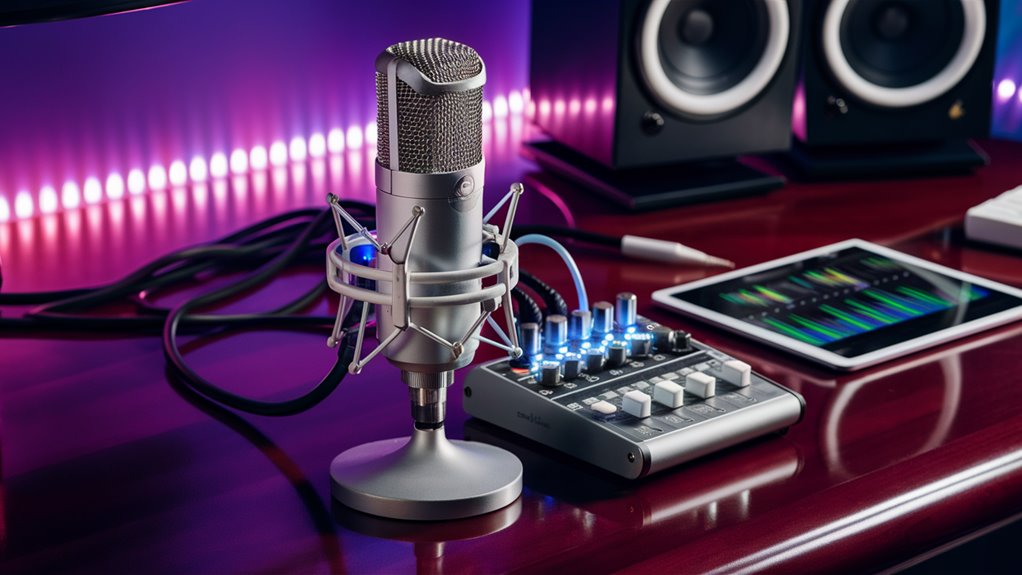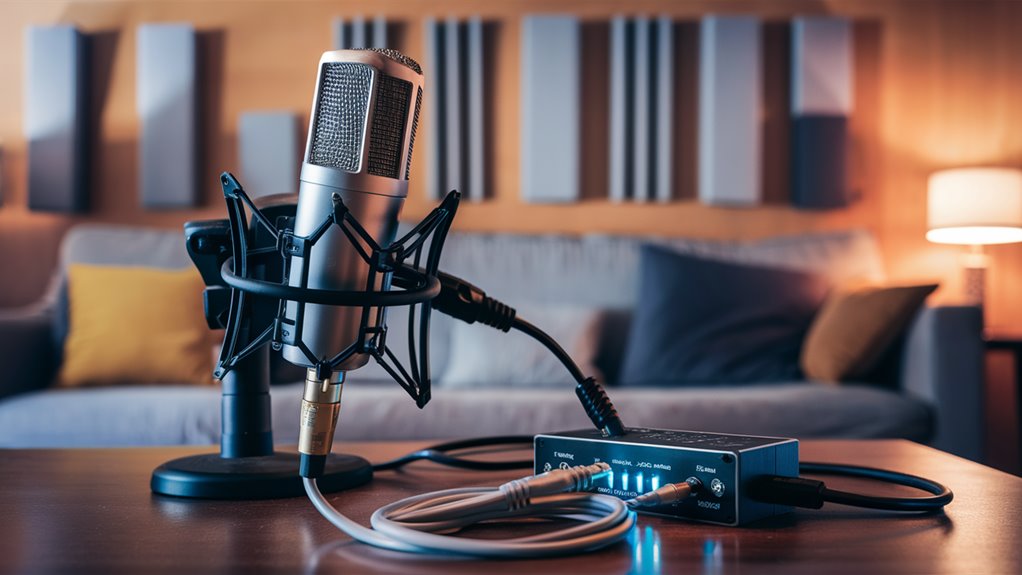DIY Karaoke Setup: Make Your Own Home Karaoke System

Key Parts for Home Karaoke
Putting together a top-notch DIY karaoke system needs you to focus on five main parts. A top-tier cardioid dynamic mic, like the Shure SM58, is key for clear singing. This should hook up to a solid audio interface for top sound handling.
Audio Gear Needs
Powered speakers that give over 50 watts RMS per side make sure the sound is loud and clear for home shows. Set your HDMI-ready screen at around 4-5 feet high for easy watching. Place speakers at the height of your ears with 45-degree angles for the best sound.
Sound Setup Tips
Make your system’s gain levels between -6dB and -12dB to stop distortion while keeping sound strong. Use a high-pass filter at 100Hz to cut out low rumble and make vocals clear. This pro setup gives studio-like sound.
Managing Digital Music
Set up a neat song list with MP3+G files named the same way. Use smart ID3 tags for quick song finding during shows. Make folders that make sense to hold more songs while keeping your system fast.
Joining Parts
Link parts with good cables and keep signals clear for less delay. Place tools so you can reach them easy during your show, keeping things running smooth. Stay on top of updates and fixes to keep your system at best form.
Must-Have Gear for DIY Karaoke Setup
Parts Overview
A pro DIY karaoke setup needs a few key parts: a good mic, audio interface, powered speakers, screen, and karaoke software.
Knowing each part helps reach the best sound and performance.
Choosing Mics
Cardioid dynamic mics are great for karaoke because they karaoke party lower feedback and catch voice well. Choose from:
- XLR mics: Pro level needs an audio interface
- USB mics: Easy to hook up to a computer
Sound Tools
If you use XLR mics, a dedicated audio interface with mic preamps is key. Things to think about:
- Need at least one mic slot
- Low-delay watching
- Phantom power
- High-quality sound change
Sound Boosting Tools
Powered speakers are best for karaoke setups:
- At least 50 watts RMS per side
- Active speaker systems mean no extra amp needed
- Balanced audio links (TRS/XLR) make sure the signal is clean
Screen and Processing Needs
Visual output choices include:
- HDMI-ready TVs
- Digital projectors for big places
- Computers that can handle it
- Dedicated graphics for smooth video
Linking and Wiring
Need-to-have connection parts:
- XLR or USB cables for mics
- Balanced audio cables for speakers
- HDMI cables for screens
- Digital audio interfaces for system joining
Best Guide to Audio System Setup
Right Positioning of Equipment
Speaker spot is big for great sound. Put powered speakers at ear level, aimed 45 degrees at the play spot.
Keep a 6-foot space between speakers for the right stereo image and sound spread. This setup maxes out sound cover while keeping feedback low.
Pro Connection Ways
Make sure you have clean signal flow by linking your audio mixer’s main outs to powered speakers with balanced XLR cables. This high-level link cuts down on noise and other interference.
With non-powered speaker systems, make sure amp power fits speaker needs to stop damage and keep sound top-notch.
Mics and Sound Handling
Use mic slots on your mixer for mics, setting gain levels just shy of feedback. Turn on 48V phantom power for condenser mics.
Mix audio sources through line-level inputs, with smart EQ tweaks:
- Cut at 250Hz to bring down muddy lower-mids
- Drop 2.5kHz to keep feedback low
- Keep voices clear with good midrange handling
Monitor Mix Setup
Set up monitor mixes for performers using floor wedges or in-ear systems. Keep stage mix separate from the main sound so singers can hear themselves well without hurting the overall sound.
Adjust monitor levels to dodge feedback while keeping it loud enough for performers.
Pro Screen and Video Setup Guide

Key Parts for Karaoke Screens
The base of a great karaoke setup is three key screen parts:
- High-definition screen system
- Pro mounting solutions
- Smart angle setup for viewing
Screen Tech Needs
A minimum 50-inch 4K screen or pro-level projector makes sure words and performance look great.
High-grade LED panels give bright, clear views, while short-throw projectors save space in small spots.
Pro Mounting Details
TV Setup
- Mount spot: 4-5 feet from ground
- VESA-ready mount systems
- Weight-checked pro brackets
- Strong wall fixes
Projector Setup
- Set throw ratio: 100-inch screen at 8-10 feet
- Screen stretch system for flat view
- Top-tier mount gear
- Exact level tweaks
Wiring and Links
- Top-level HDMI wires
- In-wall tube systems
- On-surface wire handling
- Digital signal tuning
Viewing Angle Setup
- A 30-degree view cone from the play spot
- Anti-glare spot away from light
- Brightness set for all lights
- Views from many angles tested
Pro Mic Picking and Setting Guide
Needed Mic Types for Shows
Dynamic cardioid mics are core in top audio setups.
The Shure SM58 and Sennheiser e835 shine in stressful show spots, giving top feedback drop and strong reliability. These known models keep voice top-notch while handling tough use well.
Best Gain Levels and Sound Handling
Pro gain staging needs exact setup between -6dB and -12dB on sound boards or audio interfaces. This key setup keeps enough room while stopping unwanted distortion.
Using a high-pass filter at 100Hz cuts out low sound mess and handling noise, making sure voices are super clear.
Multi-Mic Setup
Wire Picking and Signal Quality
Balanced XLR links with gold ends give top signal clean and stop interference. For no-wire setups, UHF systems in the 500-900MHz range give the best show through smart frequency handling.
Backup and Second Choices
Pro setups need a second choice through backup mic systems set with matching EQ and compression levels. This makes sure smooth change during live shows while keeping the sound consistent across all channels.
Tech Details
- Frequency range: 50Hz – 15kHz
- Highest SPL: >130dB
- Resistance: 150ohms
- Connector kind: 3-pin XLR
- Sound pattern: Cardioid
Full Guide to Song List Handling
Key Organization Tips
Digital music sorting needs a clear plan for top speed.
Create a layered folder plan sorted by key groups:
- Types
- Years
- Languages
Use same file names with this layout:
Artist – Song Name (Year) [Format]
Metadata Handling Best Ways
Right metadata tags are key for easy search and order.
Use pro music tagging tools like:
- Mp3tag
- MusicBrainz Picard
Keep ID3 tags same, with:
- Artist name
- Song name
- Album
- Year
- Type
Karaoke File Order
Karaoke content order needs special looks:
- Add clear tags (“KAR”, “Karaoke Version”)
- Keep files in common formats (MP4, CDG, MP3+G)
- Have backup copies on outside storage
- Make full database for:
- Song picks
- Language forms
- Show keys
Work Flow Tips
Put in place a clear processing plan:
- Check formats
- Standardize metadata
- Make backups
- Visit Website
- Enter into database
This neat system lets you find songs fast and lines them up smooth during shows, making things work well and upping user fun.
